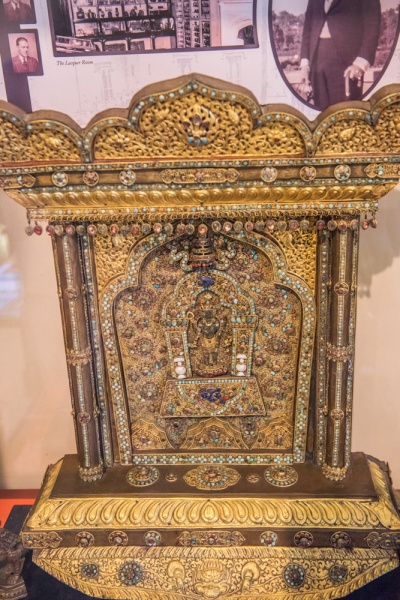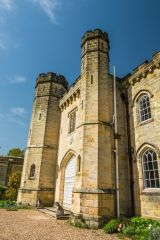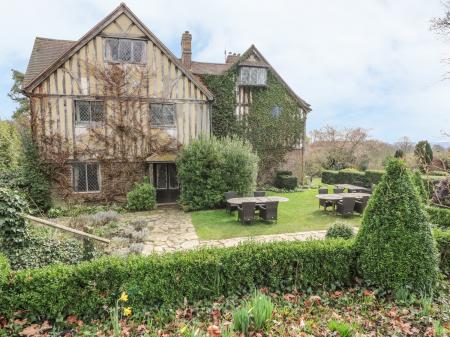
History
The first Chiddingstone Castle was built in the early 16th century by the Streatfield family as a timber-framed house. Around 1670 the Tudor house was rebuilt as High Street House, then in the early 19th century, the house was transformed yet again by Henry Streatfield, a former High Sheriff of Kent.
Streatfield wanted a house that looked like a medieval castle, and he hired architect William Atkinson to oversee the design. Part of Atkinson's design including moving the course of the High Street to make way for a lake.
The new castle was begun, but money ran out before it could be completed. Then in the 1830s Henry Streatfield's son, also named Henry, completed most of the earlier plans.
The Streatfield family left Chiddingstone in 1900, but it was not until 1938 that they sold the property to Lord Astor. The castle was used as a military base during WWII, and then as a school until 1955 when it was sold to eccentric collector Denys Bower. Bower wanted the castle, not as a home, but as a place to house his eclectic collections of oddities.

The Collections
Though the castle has a long and colourful history in its own right, it is the collections of Denys Bower that will attract most visitors. Bower collected practically anything he liked, but one of his passions was Japanese art and swords. The bulk of the collection covers the Edo period (1603-1868) and there are also a large number of swords made especially for export abroad.
Bowers also collected Egyptian antiquities, and you can see things like a 5000-year-old funerary boat, pottery, painted steles, and a letter from famed Egyptologist Flinders Petrie to Denys Bowers. The Egypt theme is reflected in the gardens, where an Ancient Egypt Garden has been designed, with a grass maze echoing the pattern of the River Nile and its tributaries.

Denys Bowers is thought to have considered himself a reincarnation of Bonnie Prince Charlie, and he was an avid collector of Jacobite and Stuart memorabilia. Included in the Jacobite collections are swords used at the Battle of Culloden, a bill to Prince Charlie for drinks, and a piece of the Garter ribbon of James II.
There are also items containing hidden Jacobite symbols, including a compass and drinking glasses. In addition, you can see a large number of documents and letters written by the Stuarts.
In the gardens is a restored Victorian orangery, a formal rose garden, and woodland walks leading to nearby Chiddingstone village.
Visiting
We came on a sunny April day, and the grounds were full of families. I quickly discovered that local residents are free to use the grounds for picnics, and quite a few families were taking opportunity of the fine weather to enjoy the spacious green lawns and the shaded picnic tables near the river that winds through woodlands between the Castle and the village.
We enjoyed a lovely woodland walk that took in the restored orangery. The orangery roof is stunning, with mullioned panes of glass creating a patchwork pattern above our heads. Next we explored the Castle itself.
What a wonderful experience! Chiddingstone Castle is worth visiting purely as a stately home, a relic of a bygone age, with a suite of period staterooms and bedchambers centred around the remarkable great hall. All is not opulence, however; you can see the original kitchens and housekeeper's room, as well as Denys Bower's study, which is a very comfortable, homely room compared to the richly decorated staterooms.

And then there are the collections, ranging from Japanese armour to a pen tray used by Florence Nightingale, a 25th Dynasty Egyptian mummy case, and a wonderfully eccentric display of Jacobite artefacts. The range of objects is remarkable, and the quality is exceptional. Chiddingstone Castle is simply wonderful, both as a historic house and a museum.
Chiddingstone Castle has seasonal opening times, but even when the Castle itself is closed to visitors you can walk in the grounds. There is a gate in the Castle wall immediately beside the Castle Inn on Chiddingstone's High Street. Inside the gate is an honesty box with a suggested donation, and for a nominal fee (2 pounds when we visited) you are allowed to explore the grounds with their woodland walks and shaded paths beside a river that runs through the estate.
The village of Chiddingstone is well worth exploring. It is entirely owned by the National Trust - with the exception of the medieval parish church and Chiddingstone Castle itself - and boasts a wonderful collection of picturesque timber-framed buildings dating to the late medieval period.









 We've 'tagged' this attraction information to help you find related historic attractions and learn more about major time periods mentioned.
We've 'tagged' this attraction information to help you find related historic attractions and learn more about major time periods mentioned.


